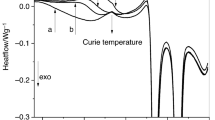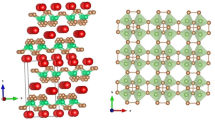Abstract
The article shows how additional information can be obtained from coupling a self constructed DTA-system with a commercially available BRUKER D8 DISCOVER GADDS XRD2-microdiffractometer. The dehydration process of gypsum to anhydrite in the temperature range from room temperature up to 723 K is used as an example. Due to the short measurement times of 10 s for each diffraction pattern the three phase transformations from gypsum to anhydrite (anhydrite II) via the hemihydrate bassanite, a water-free bassanite structure (γ-anhydrite, anhydrite III) were resolved in detail by recording the thermal signal and the diffraction pattern simultaneously. To the best of our knowledge, this is the first observation of a completely reversible dehydration/rehydration process of the bassanite/γ-anhydrite-structure around 373 K which is studied by coupled XRD and differential thermal analysis (DTA) measurements.




Similar content being viewed by others
References
Wefers K. Gleichzeitige Röntgen- und DTA-Untersuchungen fester Stoffe. Berichte der Deutschen Keramischen Gesellschaft. 1965;42(2):35–60.
Fawcett TG, et al. The rapid simulaneous measurement of thermal and structural data by a novel DSC/XRD instrument. Adv X-Ray Anal. 1985;28:227–32.
Fawcett TG, et al. Combined thermal analyzer and X-ray diffractometer. Midland: The Dow Chemical Company; 1989. p. 26.
Kishi A, Toraya H. Simultaneous measurements of X-ray diffraction (XRD) and differential scanning calorimetry (DSC) data under controlled humidity condition: instrumentation and application to studies on hydration, dehydration, and rehydration processes of pharmaceutical compounds. Powder Diffr. 2004;19(1):31–5.
Russell TP, Koberstein JT. Simultaneous differential scanning calorimetry and small-angle X-ray-scattering. J Polym Sci B. 1985;23(6):1109–15.
Bras W, et al. The combination of thermal-analysis and time-resolved X-ray techniques—a powerful method for materials characterization. J Appl Crystallogr. 1995;28:26–32.
Kalnin D, et al. Monitoring fat crystallization in aerated food emulsions by combined DSC and time-resolved synchrotron X-ray diffraction. Food Res Int. 2002;35:927–34.
Arkadiev VA, et al. Wide-band X-ray optics with a large aperture. Sov Phys Usp. 1989;32:271–6.
Kumakhov MA, Komarov FF. Multiple reflection from surface X-ray optics. Phys Rep. 1990;191(5):289–350.
Bjeoumikhov A, Bjeoumikhova S, Wedell R. Capillary optics in X-ray analysis. Part Part Syst Charact. 2005;22:384–90.
Bjeoumikhov A, Bjeoumikhova S, Wedell R. New developments and applications of X-ray capillary optics. Part Part Syst Charact. 2009;26(3):9.
Berthold C, Bjeoumikhov A, Brügemann L. Fast XRD2 microdiffraction with focusing X-ray microlenses. Part Part Syst Charact. 2009;26(3):107–11.
Chang LLY, Howie RA, Zussman J. Non-silicates: sulphates, carbonates, phosphates, halides. rock forming minerals, vol 5B. Bath: Geological Society Publishing House; 1997. p. 392.
Bezou C, Mutin JC, Nonat A. Crystal-chemistry of plaster constituent phases. Ann Chim Sci Mater. 1990;15(6):307–14.
Morris RJ. X-ray diffraction identification of the alpha- and beta-forms of calcium sulphate hemihydrate. Nature. 1963;198:1299.
Abriel W, Reisdorf K. Dehydration reactions of gypsum: a neutron and X-ray diffraction study. J Solid State Chem. 1990;85:23–30.
Deutsch Y, Nathan Y, Sarig S. Thermogravimetric evaluation of the kinetics of the gypsum hemihydrate soluble anhydrite transitions. J Therm Analy. 1994;42(1):159–74.
Hudson-Lamb DL, Strydon CA, Potgieter JH. The thermal dehydration of natural gypsum and pure calcium sulphate dihydrate (gypsum). Thermochim Acta. 1996;282/283:483–92.
Badens E, Veesler S, Boistelle R. Crystallization of gypsum from hemihydrate in presence of additives. J Cryst Growth. 1999;199:704–9.
Ballirano P, et al. The monoclinic I2 structure of bassanite, calcium sulphate hemihydrate (CaSO4 x 0.5H2O). Eur J Mineral. 2001;13(5):985–93.
Follner S, et al. The setting behaviour of alpha- and beta-CaSO4 x 0.5H2O as a function of crystal structure and morphology. Cryst Res Technol. 2003;37(10):1075–87.
Prasad PSR, et al. Direct formation of the gamma-CaSO4 phase in dehydration process of gypsum: In situ FTIR study. Am Min. 2005;90(4):672–8.
Carbone M, Ballirano P, Caminiti R. Kinetics of gypsum dehydration at reduced pressure: an energy dispersive X-ray diffraction study. Eur J Min. 2008;20:621–7.
Christensen AN, et al. Formation and transformation of five different phases in the CaSO4–H2O system: crystal structure of the subhydrate beta-CaSO4 x 0.5H2O and soluble anhydrite CaSO4. Chem Mater. 2008;20(6):2124–32.
Ballirano P, Melis E. Thermal behaviour and kinetics of dehydration in air of bassanite, calcium sulphate hemihydrate (CaSO4 x 0.5H2O) from X-ray powder diffraction. Eur J Mineral. 2009;21(5):985–93.
Ballirano P, Melis E. Thermal behaviour and kinetics of dehydration of gypsum in air from in situ real-time laboratory parallel-beam X-ray powder diffraction. Phys Chem Min. 2009;36(7):391–402.
Seufert S, et al. Discrimination of bassanite and anhydrite III dehydrated from gypsum at different temperatures. Zeitschrift Fur Kristallographie. 2009;3030:447–52.
Lippmann F. Mineralogische Untersuchungen an einigen niederhessischen Tertiärtonen (Unter besonderer Berücksichtigung der Differntialthermoanalyse). Heidelberger Beiträge zur Mineralogie und Petrographie. 1952;3:219–52.
Lippmann F. Über eine Apparatur zur Differentialthermoanalyse (DTA). Keramische Zeitschrift. 1959; Nr. 9, 10, 11, p. 475, 524, 570.
Acknowledgements
We thank the workshop team of the Institute for Geoscience Tübingen (IFG) for manufacturing the DTA block and modification of the furnace. Dr. A. Bjeoumikhov from the IFG-Adlershof is kindly acknowledged for providing the X-ray optics and valuable discussions. V. Presser gratefully acknowledges financial support from the Alexander-von-Humboldt foundation.
Author information
Authors and Affiliations
Corresponding author
Rights and permissions
About this article
Cite this article
Berthold, C., Presser, V., Huber, N. et al. 1 + 1 = 3: Coupling μ-XRD2 and DTA New insights in temperature-dependent phase transitions. J Therm Anal Calorim 103, 917–923 (2011). https://doi.org/10.1007/s10973-010-1220-z
Received:
Accepted:
Published:
Issue Date:
DOI: https://doi.org/10.1007/s10973-010-1220-z




